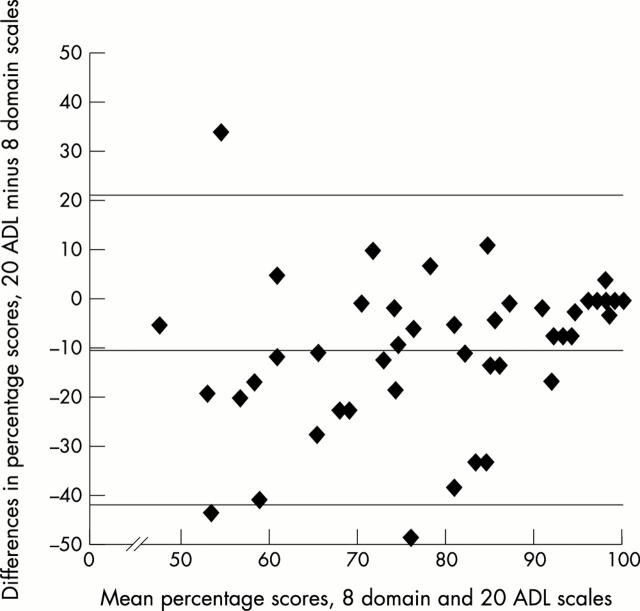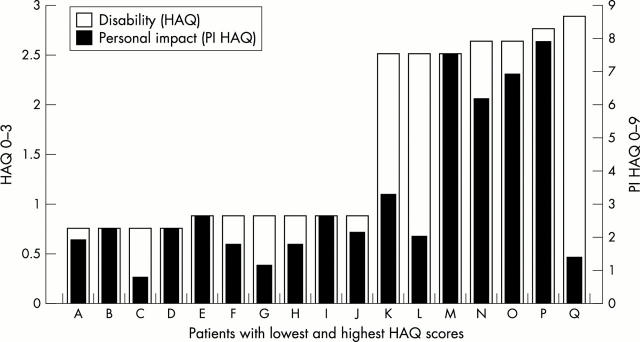Abstract
Background: Measurement of disability in rheumatoid arthritis is often used to support treatment decisions and outcome assessments, but is used without reference to the impact of disability on individual patients.
Objective: To develop and validate a scale to measure individual values for functions, which is used to weight the level of an individual patient's functional loss and thus calculate the personal impact of disability.
Methods: In four linked studies, first the phraseology for values was explored to develop a stem question for the value scale couched in terms patients understand (face validity). Then short and long versions of the value scale were compared (content validity) and tests of internal consistency and short term reliability undertaken (criterion validity). Finally, the value scale was examined for long term reliability and agreement with expected variables (criterion and construct validity), after which personal impact scores were calculated and their construct validity examined.
Results: Patients understand the concept of values, and a positively phrased stem question was developed for the value scale, for which a short version was reasonably equivalent to a long version. The value scale was reliable over one week (96% changed by <1 point) with positive interitem correlation. Reasonable six and 12 month reliability was shown (52% changed by <0.5 points), and the value scale was independent of disability and clinical, psychological, personality, and social support variables. Personal impact scores were then calculated by using the value scores to weight disability scores. Impact scores varied widely between patients of similar disability. Personal impact for disability showed convergent validity with dissatisfaction with disability, perceived increase in disability, increased disease activity, worse psychological status, low social support, and time trade off for disability. It discriminated between patients with low and high dissatisfaction with disability, life satisfaction, depression, pain, and helplessness.
Conclusion: This individualised personal impact scale should lend meaning to disability scores, improving the interpretation of clinical and research data.
Full Text
The Full Text of this article is available as a PDF (184.1 KB).
Figure 1 .
Percentage difference of eight domain and 20 ADL scales plotted against mean percentage scores of both scales (n=45).
Figure 2 .
Disability and personal impact for patients with low and high disability (study 4).
Selected References
These references are in PubMed. This may not be the complete list of references from this article.
- Arnett F. C., Edworthy S. M., Bloch D. A., McShane D. J., Fries J. F., Cooper N. S., Healey L. A., Kaplan S. R., Liang M. H., Luthra H. S. The American Rheumatism Association 1987 revised criteria for the classification of rheumatoid arthritis. Arthritis Rheum. 1988 Mar;31(3):315–324. doi: 10.1002/art.1780310302. [DOI] [PubMed] [Google Scholar]
- Bell M. J., Bombardier C., Tugwell P. Measurement of functional status, quality of life, and utility in rheumatoid arthritis. Arthritis Rheum. 1990 Apr;33(4):591–601. doi: 10.1002/art.1780330420. [DOI] [PubMed] [Google Scholar]
- Berkanovic E., Hurwicz M. L., Lachenbruch P. A. Concordant and discrepant views of patients' physical functioning. Arthritis Care Res. 1995 Jun;8(2):94–101. doi: 10.1002/art.1790080207. [DOI] [PubMed] [Google Scholar]
- Bland J. M., Altman D. G. Statistical methods for assessing agreement between two methods of clinical measurement. Lancet. 1986 Feb 8;1(8476):307–310. [PubMed] [Google Scholar]
- Buchbinder R., Bombardier C., Yeung M., Tugwell P. Which outcome measures should be used in rheumatoid arthritis clinical trials? Clinical and quality-of-life measures' responsiveness to treatment in a randomized controlled trial. Arthritis Rheum. 1995 Nov;38(11):1568–1580. doi: 10.1002/art.1780381108. [DOI] [PubMed] [Google Scholar]
- Carr A. J. Margaret Holroyd Prize Essay. A patient-centred approach to evaluation and treatment in rheumatoid arthritis: the development of a clinical tool to measure patient-perceived handicap. Br J Rheumatol. 1996 Oct;35(10):921–932. doi: 10.1093/rheumatology/35.10.921. [DOI] [PubMed] [Google Scholar]
- Diener E., Emmons R. A., Larsen R. J., Griffin S. The Satisfaction With Life Scale. J Pers Assess. 1985 Feb;49(1):71–75. doi: 10.1207/s15327752jpa4901_13. [DOI] [PubMed] [Google Scholar]
- Fries J. F., Spitz P., Kraines R. G., Holman H. R. Measurement of patient outcome in arthritis. Arthritis Rheum. 1980 Feb;23(2):137–145. doi: 10.1002/art.1780230202. [DOI] [PubMed] [Google Scholar]
- Fuchs H. A., Brooks R. H., Callahan L. F., Pincus T. A simplified twenty-eight-joint quantitative articular index in rheumatoid arthritis. Arthritis Rheum. 1989 May;32(5):531–537. doi: 10.1002/anr.1780320504. [DOI] [PubMed] [Google Scholar]
- Giorgino K. B., Blalock S. J., DeVellis R. F., DeVellis B. M., Keefe F. J., Jordan J. M. Appraisal of and coping with arthritis-related problems in household activities, leisure activities, and pain management. Arthritis Care Res. 1994 Mar;7(1):20–28. doi: 10.1002/art.1790070106. [DOI] [PubMed] [Google Scholar]
- Hewlett S., Smith A. P., Kirwan J. R. Values for function in rheumatoid arthritis: patients, professionals, and public. Ann Rheum Dis. 2001 Oct;60(10):928–933. doi: 10.1136/ard.60.10.928. [DOI] [PMC free article] [PubMed] [Google Scholar]
- Hewlett S., Young P., Kirwan J. Dissatisfaction, disability, and rheumatoid arthritis. Arthritis Care Res. 1995 Mar;8(1):4–9. doi: 10.1002/art.1790080104. [DOI] [PubMed] [Google Scholar]
- Katz P. P., Yelin E. H. The development of depressive symptoms among women with rheumatoid arthritis. The role of function. Arthritis Rheum. 1995 Jan;38(1):49–56. doi: 10.1002/art.1780380108. [DOI] [PubMed] [Google Scholar]
- Kirwan J. R., Reeback J. S. Stanford Health Assessment Questionnaire modified to assess disability in British patients with rheumatoid arthritis. Br J Rheumatol. 1986 May;25(2):206–209. doi: 10.1093/rheumatology/25.2.206. [DOI] [PubMed] [Google Scholar]
- Kwoh C. K., O'Connor G. T., Regan-Smith M. G., Olmstead E. M., Brown L. A., Burnett J. B., Hochman R. F., King K., Morgan G. J. Concordance between clinician and patient assessment of physical and mental health status. J Rheumatol. 1992 Jul;19(7):1031–1037. [PubMed] [Google Scholar]
- Lubeck D. P., Yelin E. H. A question of value: measuring the impact of chronic disease. Milbank Q. 1988;66(3):444–464. [PubMed] [Google Scholar]
- Meenan R. F., Gertman P. M., Mason J. H. Measuring health status in arthritis. The arthritis impact measurement scales. Arthritis Rheum. 1980 Feb;23(2):146–152. doi: 10.1002/art.1780230203. [DOI] [PubMed] [Google Scholar]
- Pincus T., Summey J. A., Soraci S. A., Jr, Wallston K. A., Hummon N. P. Assessment of patient satisfaction in activities of daily living using a modified Stanford Health Assessment Questionnaire. Arthritis Rheum. 1983 Nov;26(11):1346–1353. doi: 10.1002/art.1780261107. [DOI] [PubMed] [Google Scholar]
- Ramey D. R., Raynauld J. P., Fries J. F. The health assessment questionnaire 1992: status and review. Arthritis Care Res. 1992 Sep;5(3):119–129. doi: 10.1002/art.1790050303. [DOI] [PubMed] [Google Scholar]
- Rothwell P. M., McDowell Z., Wong C. K., Dorman P. J. Doctors and patients don't agree: cross sectional study of patients' and doctors' perceptions and assessments of disability in multiple sclerosis. BMJ. 1997 May 31;314(7094):1580–1583. doi: 10.1136/bmj.314.7094.1580. [DOI] [PMC free article] [PubMed] [Google Scholar]
- Scheier M. F., Carver C. S. Optimism, coping, and health: assessment and implications of generalized outcome expectancies. Health Psychol. 1985;4(3):219–247. doi: 10.1037//0278-6133.4.3.219. [DOI] [PubMed] [Google Scholar]
- Stein M. J., Wallston K. A., Nicassio P. M. Factor structure of the Arthritis Helplessness Index. J Rheumatol. 1988 Mar;15(3):427–432. [PubMed] [Google Scholar]
- Stensman R. Severely mobility-disabled people assess the quality of their lives. Scand J Rehabil Med. 1985;17(2):87–99. [PubMed] [Google Scholar]
- Tijhuis G. J., Jansen S. J., Stiggelbout A. M., Zwinderman A. H., Hazes J. M., Vliet Vlieland T. P. Value of the time trade off method for measuring utilities in patients with rheumatoid arthritis. Ann Rheum Dis. 2000 Nov;59(11):892–897. doi: 10.1136/ard.59.11.892. [DOI] [PMC free article] [PubMed] [Google Scholar]
- Tugwell P., Bombardier C. A methodologic framework for developing and selecting endpoints in clinical trials. J Rheumatol. 1982 Sep-Oct;9(5):758–762. [PubMed] [Google Scholar]
- Yelin E., Lubeck D., Holman H., Epstein W. The impact of rheumatoid arthritis and osteoarthritis: the activities of patients with rheumatoid arthritis and osteoarthritis compared to controls. J Rheumatol. 1987 Aug;14(4):710–717. [PubMed] [Google Scholar]
- Zigmond A. S., Snaith R. P. The hospital anxiety and depression scale. Acta Psychiatr Scand. 1983 Jun;67(6):361–370. doi: 10.1111/j.1600-0447.1983.tb09716.x. [DOI] [PubMed] [Google Scholar]
- de Jong Z., van der Heijde D., McKenna S. P., Whalley D. The reliability and construct validity of the RAQoL: a rheumatoid arthritis-specific quality of life instrument. Br J Rheumatol. 1997 Aug;36(8):878–883. doi: 10.1093/rheumatology/36.8.878. [DOI] [PubMed] [Google Scholar]




